Its beak caught firmly
In the clam shell,
The snipe cannot
Fly away
Of an autumn evening
– Yadoya no Meshimori (1754–1830)
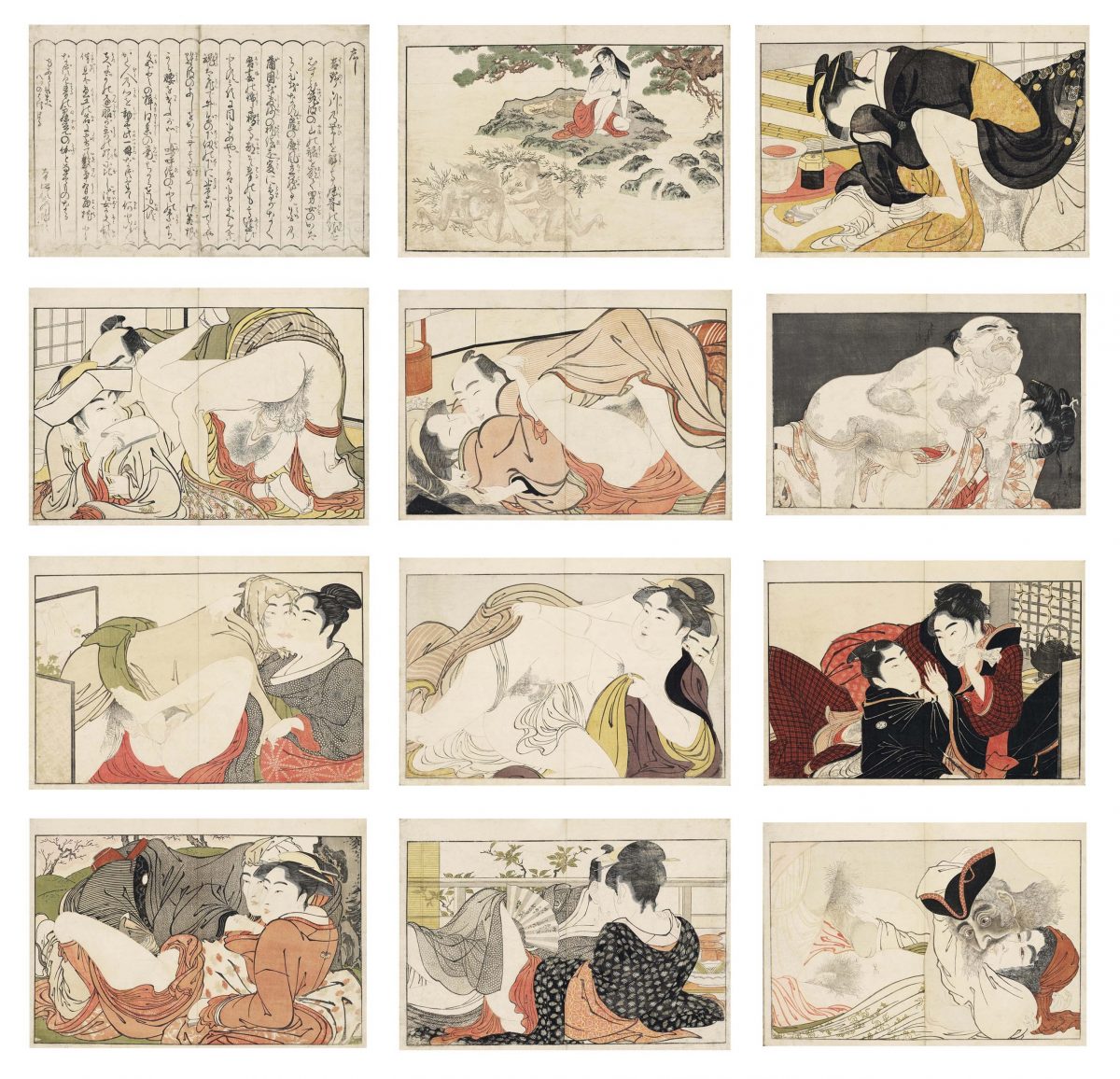
Utamakura (‘Poems of the Pillow’) is an illustrated book of sexually explicit shunga pictures, celebrations of sexual please and intimacy. Published in 1788, the 12 prints were created by Japanese ukiyo-e artist Kitagawa Utamaro. (c. 1753 – 31 October 1806). Very little is known about the artist. We don’t know his date of birth. He left no letters, diaries and there is no mention of him in official records. There are no known pictures of him. But perhaps that’s him in the sublime 11th panel of his erotic book, his eye looking out at us from beneath his lover’s hair?
Immersed in the intimate world of courtesans, geishas and their on-the-clock lovers in the red-light district of Ed0 (now Tokyo), Utamaro’s figures are possessed of a cool, dignified elegance. You see the dreamy swirls and flow of movement before the details strikes you and you get to wonder about the meaning of what you see.
Each bold line matters and conveys an idea. As Vincent Van Gogh, an avid collector and copyist of Japanese art stated in a letter to his brother:
I envy the Japanese the extreme clarity that everything in their work has. It’s never dull, and never appears to be done too hastily. Their work is as simple as breathing, and they do a figure with a few confident strokes with the same ease as if it was as simple as buttoning your waistcoat. Ah, I must manage to do a figure with a few strokes. That will keep me busy all winter. Once I have that, I’ll be able to do people strolling along the boulevards, the streets, a host of new subjects. While I’ve been writing you this letter, I’ve drawn a good dozen of them. I’m on the track of finding it. But it’s very complicated, because what I’m after is that in a few strokes the figure of a man, a woman, a kid, a horse, a dog, will have a head, a body, legs, arms that will fit together.
A little warning: some of the images below are NSFW.

PREFACE
The Preface translated:
Loosening the sash of Yoshino River, forging a bond ‘twixt Imo and Se mountains, spreading the skirts of Mount Tsukuba – thus do lovers plight their troth. Enveloping themselves in a screen of mist, spreading a quilt of flowers, reaching for a pillow … We hereby print pillow pictures in brocades of the East as a plaything of spring at court. With one glance the eye is startled, the heart throbs, the spirit leaps [Ide], pausing below the sash, pressing, pressing, entwining the legs like the reeds of Naniwa, from the jewel-comb box of Hakone onwards, it is akin to using the hips. Ah! Rather than some amateur at drawing, the brush of one who is skilled in the art of love, without pressing too hard, this is the way to move the hearts of men. And so, what name shall I give this volume? Why yes, likening it to a poem by Bishop Henjō, borrowing the title of a letter by Lady Sei, and even coming close to the name of the artist, I call it Ehon utamakura, “Poem of the Pillow” — a companion to awakening in spring perhaps.
First spring, 1788
Honjo no Shitsubuka

Two kappa river creatures appear to be attacking an ama diver underwater. Another ama watches
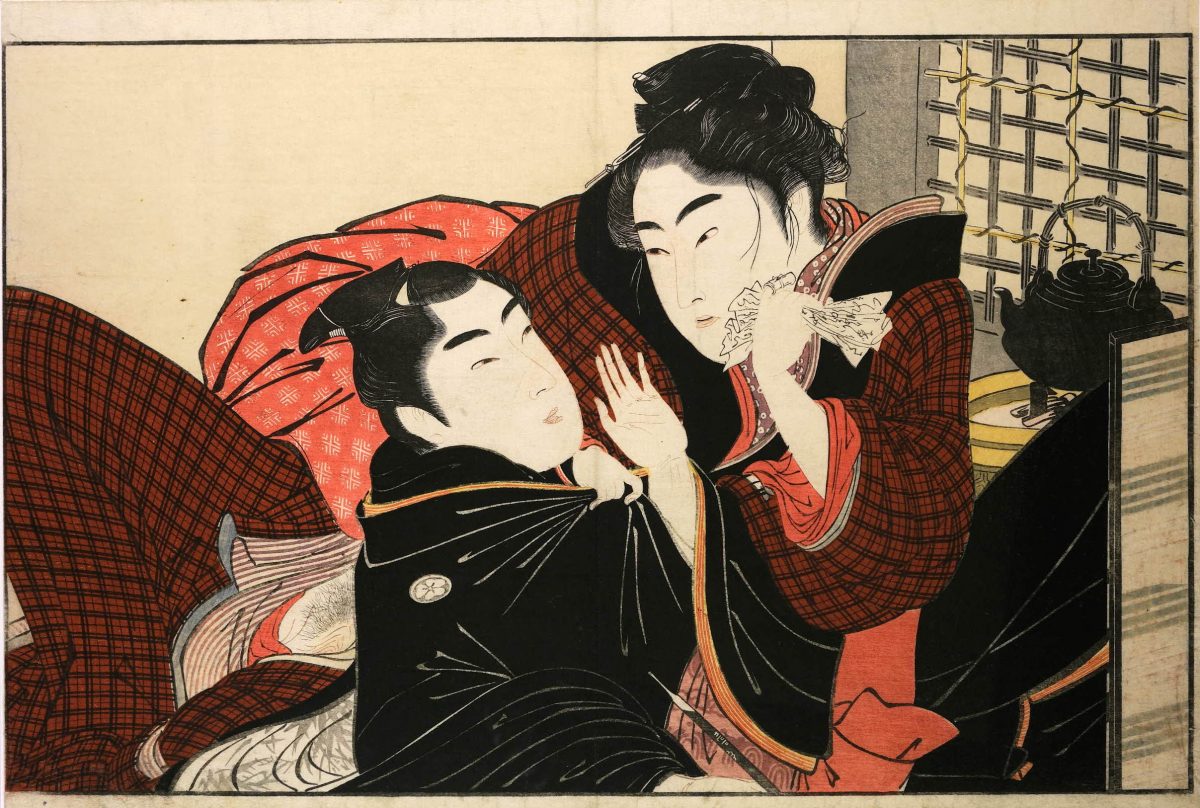
A wakashū (adolescent boy) and his older lover. The woman has discovered a letter in his robes. Her little finger is bandaged; Edo-period courtesans cut a little finger as a sign of faith towards a man.
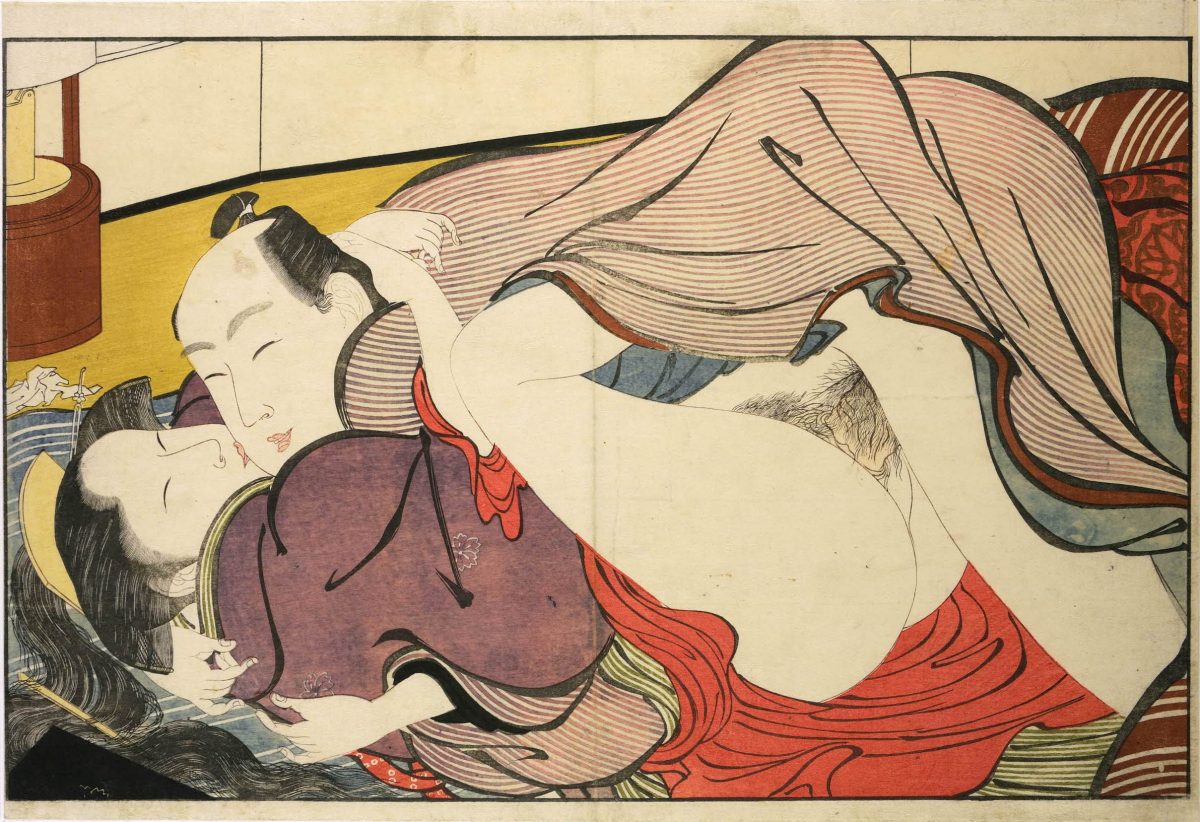
She has shaved eyebrows, indicating she is married. The pair appear to be on a bedroom floor surrounded by a byōbu folding screen, but that she is still in her kimono suggests her partner is not her husband.
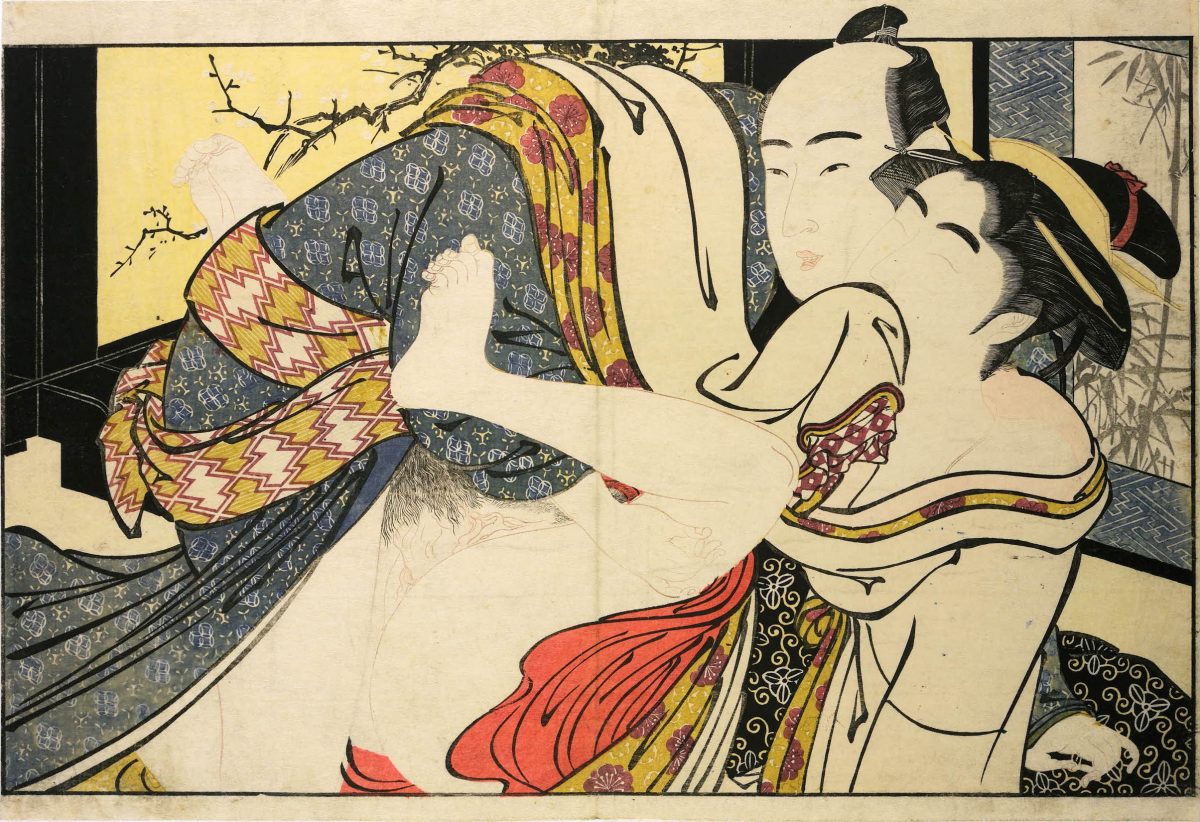
He is a samurai, and his topknot protrudes beyond the enclosing frame of the image. The woman’s kimono bears a Japanese primrose mon crest, a mark born by the geisha Tomimoto Toyohina, whom Utamaro often depicted.
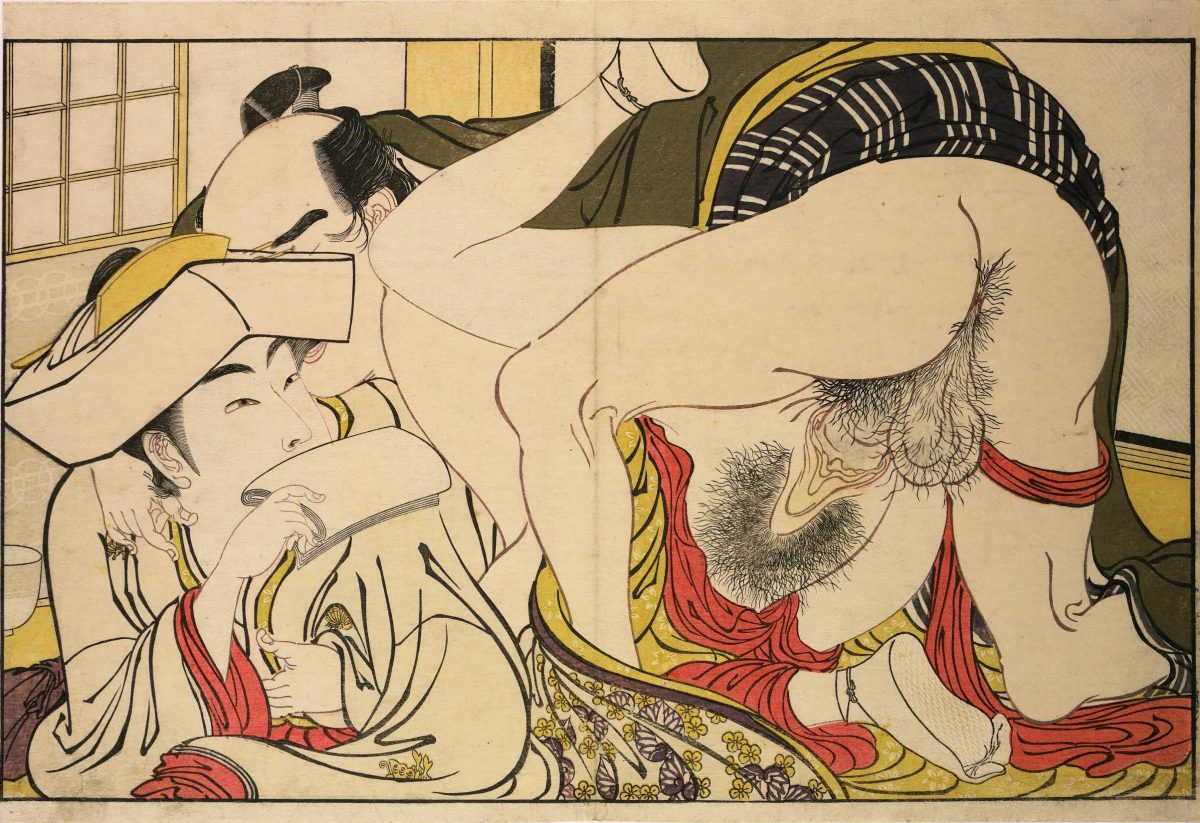
From the woman’s tsunokakushi headdress the scene is presumed to take place at a shrine; since the Meiji period (1868–1912), the tsunokakushi has come to be associated with Japanese weddings, but in the Edo period they were used for temple visits. The picture suggests the visit was but a pretence for a secret trystbetween what are probably servants in samurai mansions.
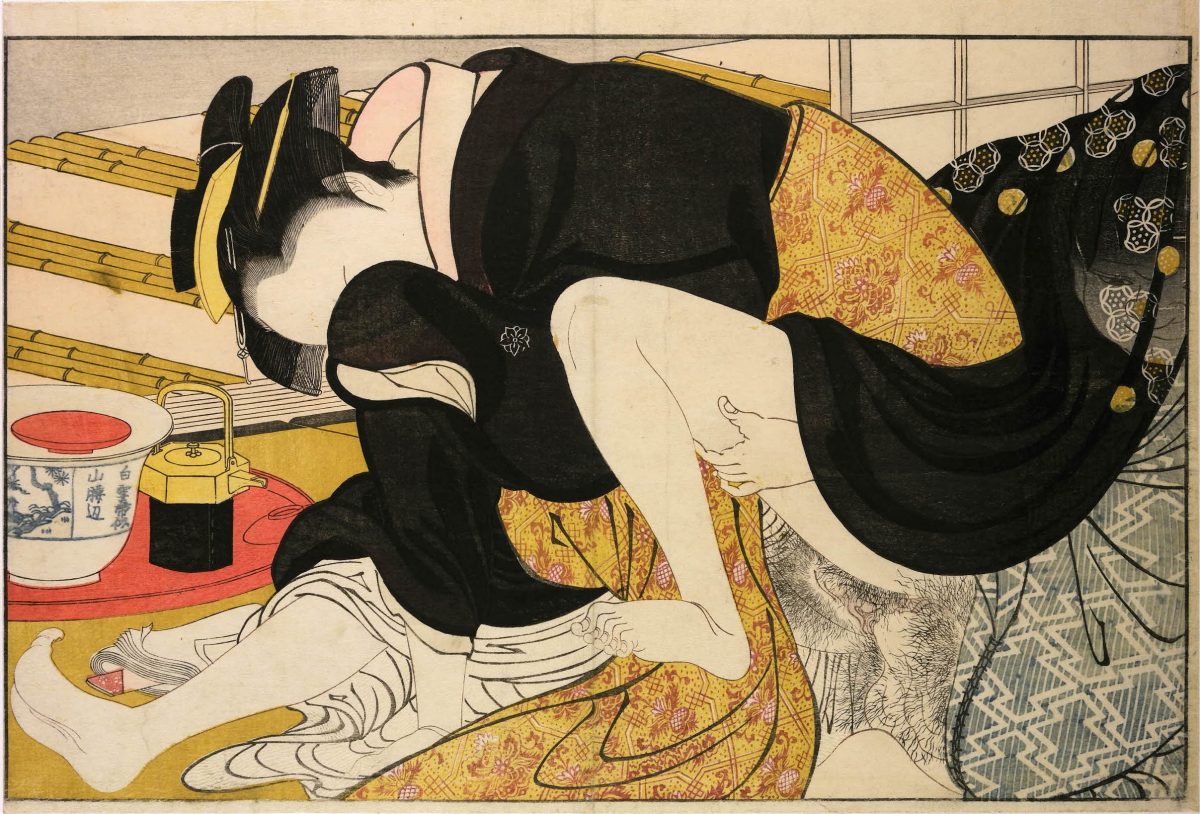
A pair has sex on the floor by an open veranda.[22] By the threshold of the veranda sits a sake set on a tray with sakazuki[c] sake cups[23] and a chōshi[d] sake decanter[24] on it, suggesting the scene follows a Budhhist memorial service.[23]
The woman’s eyebrows are shaved, indicating a married woman, but her black kimono suggests she has recently been widowed. She covers her face, perhaps in shame, and her emotional state is expressed in her tensed toes.
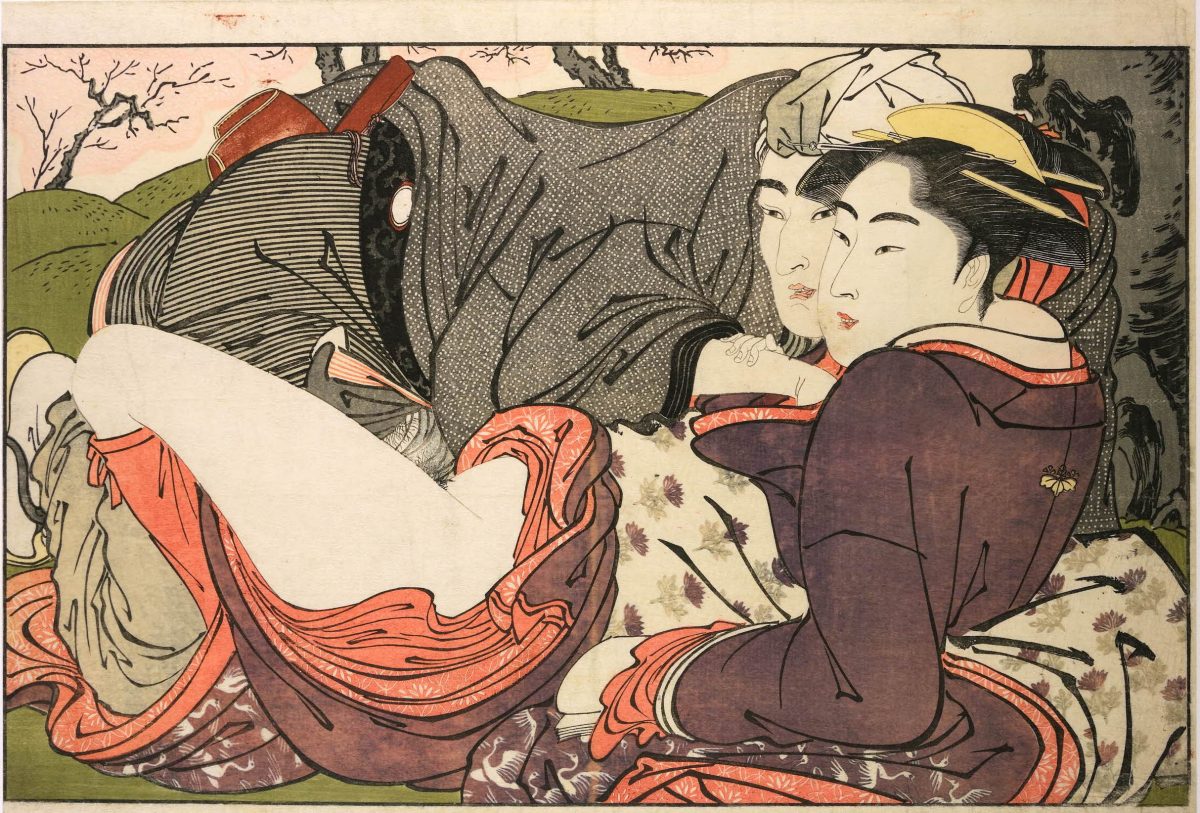
A pair of lovers have sex beneath a sakura cherry tree in bloom.The woman is dressed as a geisha.
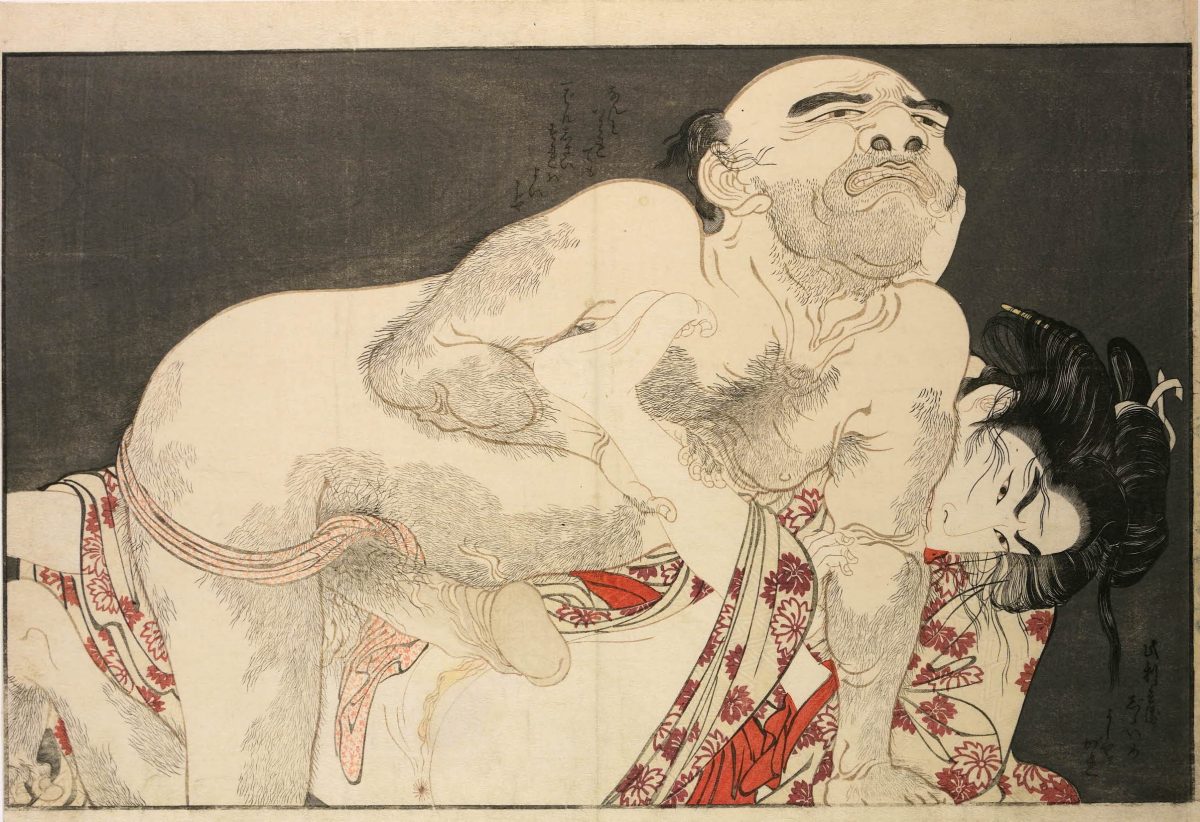
A young woman tries to fight off an older man who is raping her; she bites his arm. Such violence is rare in Edo-period shunga, and the perpetrators are usually depicted as ugly.
This is the only print in the book that includes dialogue. In the inscription in the lower right the woman says:
此利兵衛じじいめ、よしやァがれ
Kono Rihei jijii-me yoshaagare
Let go of me Rihei, you old fool!
In the inscription above him the man replies:
なんといわれても一ばんしさいすればよいのじゃ
Nan to iwarete mo ichiban shisai sureba yoi no ja
Save your words and just keep still
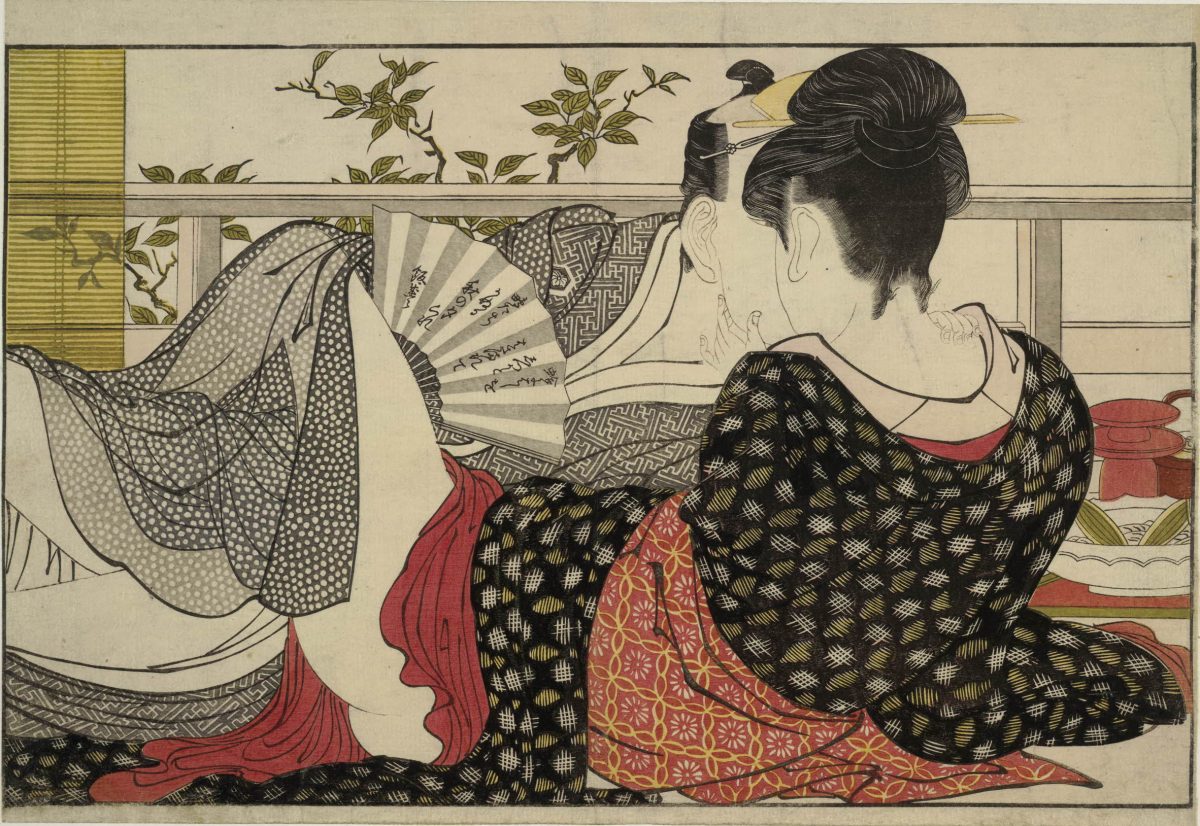
A pair of lovers make love on the floor in a room on the second story of a teahouse. A close look reveals the man’s right eye peering out just below the edge of the woman’s hair.
The man holds a hand fan on which is inscribed a kyōka poem by Yadoya no Meshimori: ‘Its beak caught firmly In the clam shell, The snipe cannot Fly away Of an autumn evening’
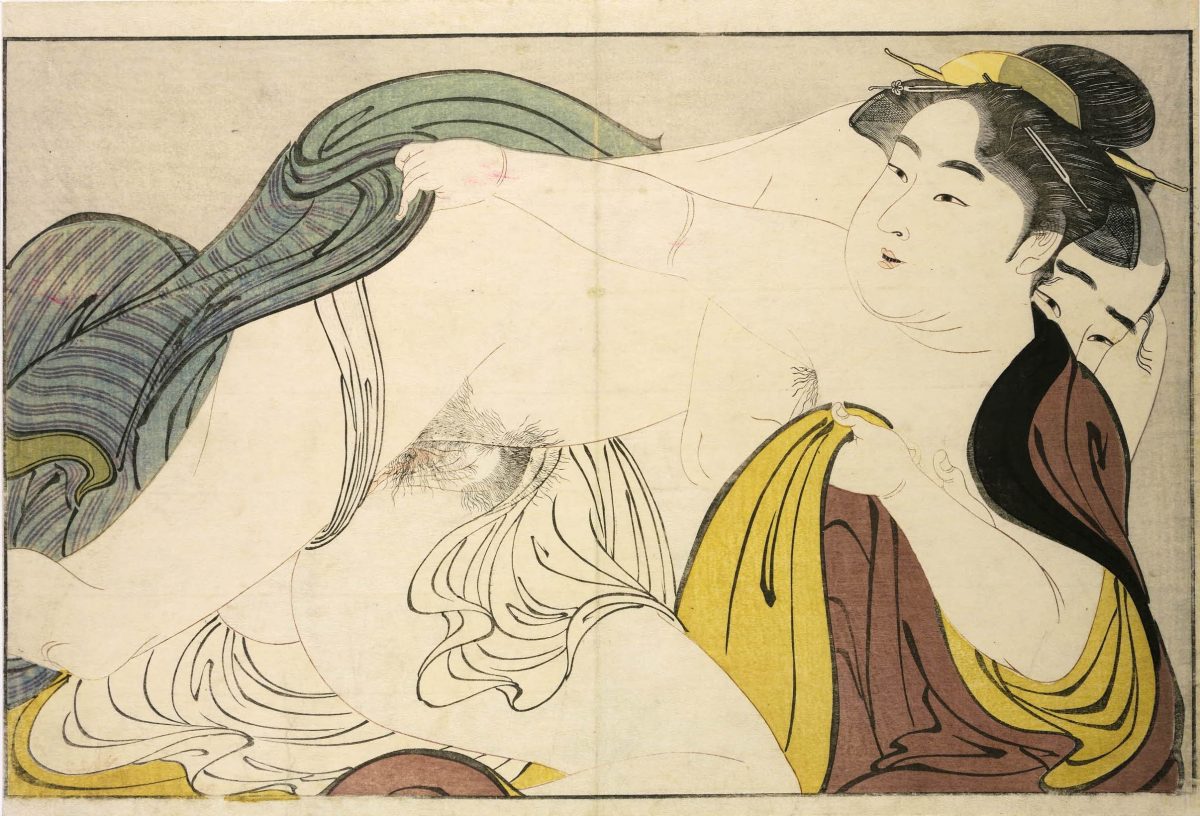
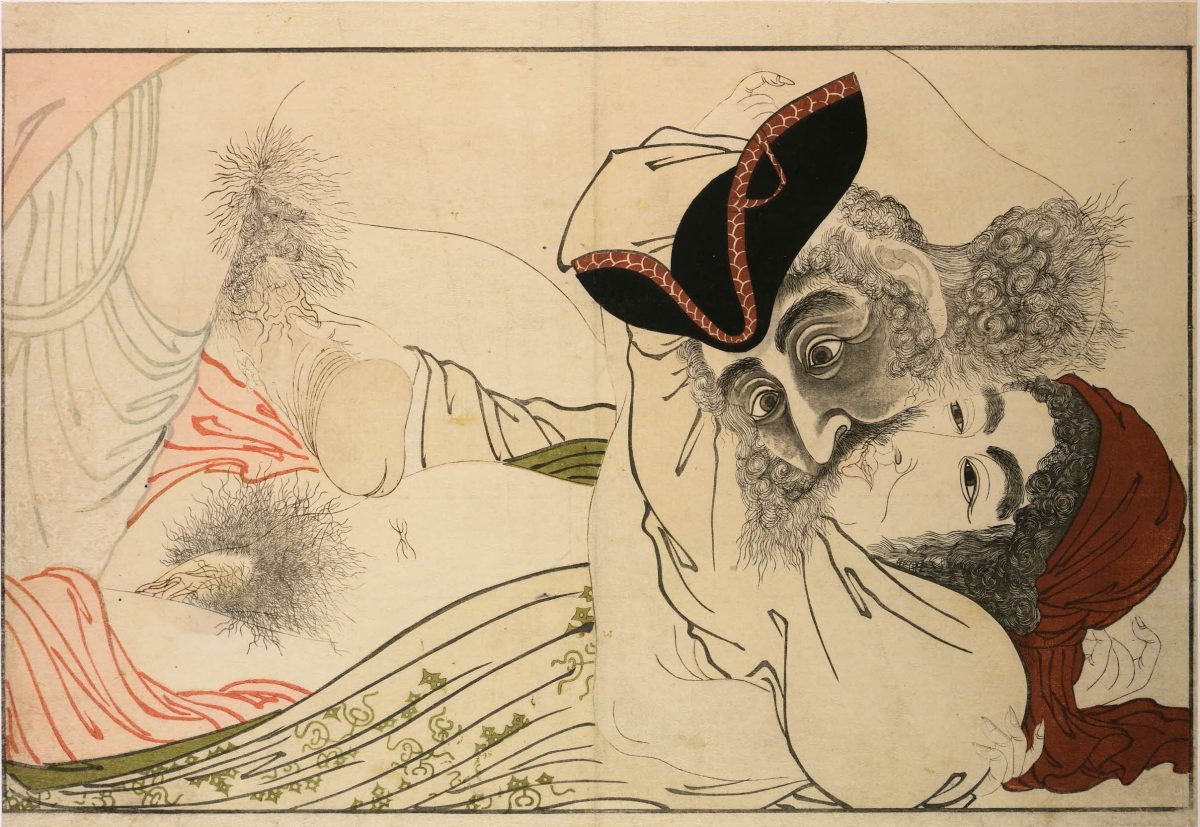
Two Westerners having sex. The print appeared when the Dutch East India Company was still making trips to Japan; they normally arrived in spring, which brought the Dutch arrivals associations with the erotic connotations of spring, as in the term shunga (春画, “spring pictures”). More here.
Via: British Museum,
Would you like to support Flashbak?
Please consider making a donation to our site. We don't want to rely on ads to bring you the best of visual culture. You can also support us by signing up to our Mailing List. And you can also follow us on Facebook, Instagram and Twitter. For great art and culture delivered to your door, visit our shop.

